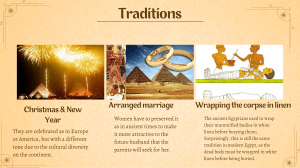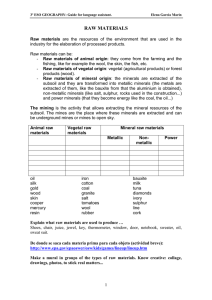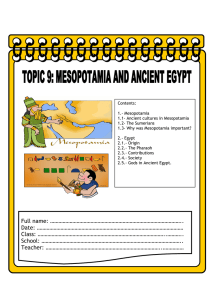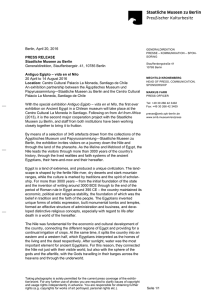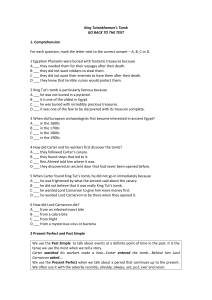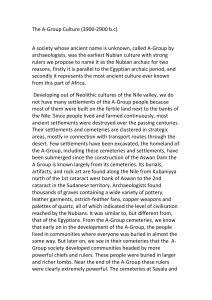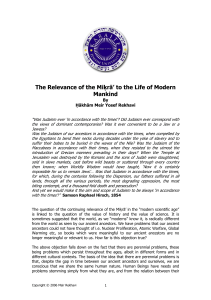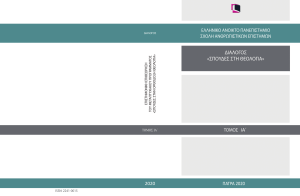PREHISTORY Activities
Anuncio
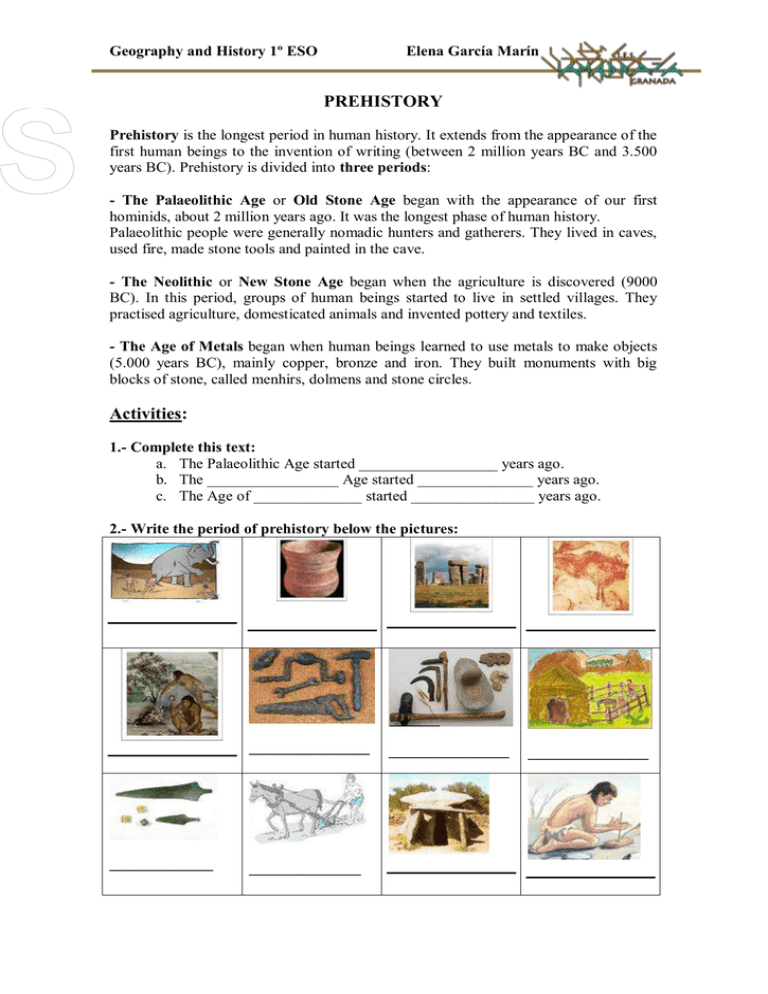
Geography and History 1º ESO Elena García Marín PREHISTORY Prehistory is the longest period in human history. It extends from the appearance of the first human beings to the invention of writing (between 2 million years BC and 3.500 years BC). Prehistory is divided into three periods: - The Palaeolithic Age or Old Stone Age began with the appearance of our first hominids, about 2 million years ago. It was the longest phase of human history. Palaeolithic people were generally nomadic hunters and gatherers. They lived in caves, used fire, made stone tools and painted in the cave. - The Neolithic or New Stone Age began when the agriculture is discovered (9000 BC). In this period, groups of human beings started to live in settled villages. They practised agriculture, domesticated animals and invented pottery and textiles. - The Age of Metals began when human beings learned to use metals to make objects (5.000 years BC), mainly copper, bronze and iron. They built monuments with big blocks of stone, called menhirs, dolmens and stone circles. Activities: 1.- Complete this text: a. The Palaeolithic Age started __________________ years ago. b. The _________________ Age started _______________ years ago. c. The Age of ______________ started ________________ years ago. 2.- Write the period of prehistory below the pictures: ______________ ____________ _____________ ______________ ______________ Geography and History 1º ESO Elena García Marín 3.- What is Prehistory? 4.- What is the difference between Prehistory and History? 5.- What periods does the Prehistory have? 4. What periods does the History have? LIFE IN THE PALAEOLITHIC AGE - The fist human beings lived from hunting (mammoths, bears, elephants, deer, bison...), fishing and gathering wild fruit. They were nomadic: they did not live in a fixed place. They lived in caves, outdoors, or in wood huts. They were organised in small tribes, made up of members of the same family. They made tools and objects of stone to hunt and cut animals’ skins and meat. Fire was an important discovery. They used fire to heat their caves, cook food and drive wild animals away. They believed in supernatural forces which helped them in hunting, births... and they believed in an afterlife. Activities: 1.- True or False. Then correct the false sentences. - Cave people lived in small groups. - They always lived in the same place. - They used fire to cook their food. - They made their clothes from plastic material. - Cave paintings show the life of the cave people. 2.- Fill in the following sentences using these words: Scientists - Mammoths - hunting - extinction - years - weather - disappeared __________________ are the ancestors of elephants. They become extinct a million _________ ago. Why did this happen? Scientists believed that it was due to climate change: the _______________ became hotter and the mammoths could not adapt. But other _____________ have discovered that mammoths ______________ gradually. Was the _______________ of mammoths caused by _______________? Geography and History 1º ESO Elena García Marín 3.- Look and complete the picture with the following words: hunting - fire - deer - animal skin - fishing - gathering - wood hut 4.- What was fire used for? 5.- CAN YOU SURVIVE IN THE ICE AGE?Answer the following questions: a) Where do you find your food during the Ice Age? - Shops - Farms - Wild animals b) What are your clothes made of? - Leather - Wool and cotton - Polyester and acrylic c) Can you hunt animals using... - Bow and arrow - Spears and traps - Guns d) Which materials do you use to make tools? - Metals - Stones, bones, antlers and ivory - Plastics e) Where would you live? - Wooden huts and caves - Houses - Castles Geography and History 1º ESO Elena García Marín PREHISTORIC ART THE PALAEOLITHIC AGE: CAVE ART People in the Palaeolithic Age created the first paintings on the walls of the caves. These are the first cave paintings. These cave paintings generally represent animals (horses, bison, reindeer, deer, mammoth). The painters drew them with great naturalism. They used the irregularities in the rocks to obtain an impression of volume. These paintings are polychrome: the base colors are red, ochre and black. It is thought that these representations were part of magic rituals. Their function was to help the people who painted them hunt the animals. The most famous cave paintings of the Palaeolithic are in the Lascaux caves (France) and in Altamira (Spain). THE NEOLITHIC AGE Around 8.000 BC the Neolithic Age or New Stone Age or the polished Stone Age began in the Middle East. People lived in houses grouped in villages and become sedentary. They started practicing agriculture (they grew cereals and vegetables). They also domesticated animals (sheep, goats, pigs and cows). It was also the beginning of handicrafts (they made pottery and they wove their clothes from sheep’s wool. THE AGE OF METALS Around 5.000 BC the first metals appeared in the Middle East. People worked different metals: first copper, then bronze (copper + tin) and around 2.000 BC iron metal appeared. With copper, people created ornaments and jewellery. With bronze and iron, they made weapons and tools more solid which gradually replaced tools made of stone. Activities: 1.- What colors did the cave painters use? 2.- In which Age was it painted? 3.- When did the Neolithic Age begin? 4.- During the Palaeolithic Age, people were nomads. What were they during the Neolithic Age? 5.- Which three activities did people do during the Neolithic Age? 6.- Which was the first metal to appear during the Metal Ages? 7.- What is bronze made of? What did metal tools replace? Geography and History 1º ESO Elena García Marín WHAT IS MESOPOTAMIAN SOCIETY LIKE? Mesopotamian society has privileged and non-privileged groups. Privileged people are very rich and have all the power: - The aristocracy consists of the king’s family and the nobility. They govern and own most of the land. The king is a religious and military leader. - Priests control religious rituals, agriculture and taxes. - Scribes write laws and commercial transactions. They know how to read, write and count. Non-privileged people are free people or slaves: - Peasants or country people are free, but they rent the lands around cities from the king or the temple. Peasants have to give part of the crops to the king or temple. They cultivate crops, such as wheat, beans and barley, and use simple ploughs. - Craftsmen work in workshops. There are different types of craftsmen, such as carpenters, weavers and jewellers - Slaves are war prisoners. They have no rights. Exercises: 1.- Make a social pyramid: Fill in the gaps with the following words: Craftsmen and Peasants - Scribes - king and nobility - slaves - priests - The groups with a high social position are at the top. - The groups with low social position are at the bottom. 2.- What is the difference between a slave and a free person? 3.- What do scribes do? 4.- What do priests do? 5.- Who is the king? 6.- What do peasants cultivate? 7.- Who is the owner of the land in Mesopotamian society? Geography and History 1º ESO Elena García Marín MESOPOTAMIA QUIZ 1. Where was Mesopotamia located? 2. What does Mesopotamia mean? 3. What are the names of the two important rivers in Mesopotamia? Why is it called “Fertile Crescent”? 4. Name three things invented by the Mesopotamians 5. What type of writing was used in Mesopotamia? 6. Did they use paper to write? Where did they write on? 7. Who was Hammurabi? 8. What is polytheism? 9. What is a “ziggurat”? 10. Write the name of some important towns in Mesopotamia Geography and History 1º ESO Elena García Marín GEOGRAPHY OF EGYPT Complete the map of Ancient Egypt: Colour: - Blue for seas and the Nile River - Yellow for desert land - Green for fertile land Locate on the map: -Menphis and Thebes -The Mediterranean sea -The Red Sea -The Nile -Upper Egypt -Lower Egypt -The Giza and Saqqara pyramids EGYPTIAN RELIGIOUS BELIEFS The Egyptians are polytheistic: they believe in many gods. The principal god is the Sun, called Ra, Amun or Atum. Other important gods are Isis, Osiris and Horus. Each god had a temple, where a group of priests made offerings to its statue. Some gods and goddesses are identified with particular animals. There is often a connection between the god or goddess and the actions of the animal. For example, the goddess of war has the head of a lioness to show that she is ferocious. Egyptians believe that the pharaohs are gods. Nobody can look at the pharaoh in the eye or touch his body. They believe that the pharaohs have magical powers. The pharaoh is all-powerful. He passes laws, rules the country, owns most of land, controls trade and leads the armies. Egyptians believe there is an afterlife, so the dead body has to be preserved. It is made a mummy, which is put in a sarcophagus. The tombs contain the things which are necessary in the afterlife, such as food, jewels or statues of servants. Geography and History 1º ESO Elena García Marín MATCH THE EGYPTIANS GODS AND GODDESS The protector of the ruler of Egypt. She is the wife of Osiris and the mother of Horus. Her symbol is a throne. The sun god Man with a jackal head The god of the desert and the chaos Man with head of a falcon. He is the son of Isis and Osiris Ra Osiris Isis The god of the dead Man with a sun disk. He is the most important god of the ancient Egyptians A protective goddess of the dead people Man with the head of an ibis. A protective goddess, the nature goddess. The brother and husband of Isis, and the brother of Nephthys and Seth. He is also the father of Horus. The god of embalming and the dead, guardian of tombs and pyramids. She is the sister of Isis and Osiris, and the sister/wife of Seth. She is also the mother of Anubis. Horus Seth Anubis Thoth The god of writing and knowledge Nephthys He is the brother of Osiris and Isis, as well as the brother/husband of Nephthys. He murdered his brother Osiris Geography and History 1º ESO civilization desert fertile flood gold hieroglyphics Elena García Marín mummy Nile River papyrus pharaoh pyramid sand sarcophagus scribe temple tomb trade irrigation Geography and History 1º ESO Elena García Marín HIEROGLYPHS AND SCRIBES Scribes are people in ancient Egypt (usually men) who learned to read and write. To become a scribe, you had to attend a special school for scribes. At this school you would learn how to read and write hieroglyphic. This was hard work. This writing was complicated, and there were many signs to learn. Scribes usually wrote on papyrus. The Egyptian writing is the hieroglyphs. Hieroglyphs were created 5.000 years ago. Some hieroglyphic signs represent an idea while others represent a sound. Egyptians could write horizontally, vertically, from left to right or from right to left. Activities: 1. Look at the key and try to write your name using Egyptian characters : 2. Write these ideas using hieroglyphs: - god: - pharaoh: - tomb: -scribe 3. True or false: correct the false sentences - The Egyptians are polytheists. - The Egypt temple is the Ziggurat. - The Egyptian writing is cuneiform. - Small statues, jewels and other treasures are placed in the tombs of important people. - All Egyptian people go to the temple for visiting the god statue. - The hieroglyphs are letters and drawings. - The Egyptians believe in the afterlife. Geography and History 1º ESO Elena García Marín CROSSWORD ACROSS: 1. King of Ancient Egypt. 2. They controlled the religious rites in Ancient Egypt. 4. People who could read, write and count. 5. They sold products. . DOWN: 3. Members of the pharaoh’s family. They had large pieces of land. 6. People with no rights. 7. They cultivated the land Match each bold word with its definition in English: 1.Polytheism a) a ceremonial practice 2.Gods b) life after death 3.Goddess c) a male deity 4.Underworld d) the world of the dead, located below the world of the living 5.Afterlife e) a person whose job it is to perform religious rites 6.Temple f) a belief in many gods 7.Priests g) a building or place dedicated to the religious ceremonies 8.Rites h) a female god Geography and History 1º ESO Elena García Marín Tick true sentences about Ancient Egypt - Religion was very important in ancient Egypt. - Religion was not very important in ancient Egypt. - Ancient Egyptians adored only one god. - Ancient Egyptians adored several gods and goddesses. - Gods adopted human forms. - Gods adopted animal forms. - “The Book of the Dead” was a famous novel in ancient Egypt - “The Book of the Dead” contains everything about religion in ancient Egypt. - Temples were a meeting point for the followers of the ancient Egyptian religion - Temples were the houses of the gods in ancient Egypt. - Every temple in ancient Egypt was dedicated to Osiris. - Each city dedicated its temple to a particular god in Ancient Egypt. - Priests in ancient Egypt prayed all day. - Priests in ancient Egypt had a lot of responsibilities. - Ancient Egyptian religion was monotheistic. - Ancient Egyptian religion was polytheistic. Talk to your partner • Who is she? • Can you describe her to your partner? Use these words in your description: hair brown eyes dark nose thin lips long neck small • Why do you think the sculptor made a statue of her? • Do you think she’s beautiful? Write three sentences about this statue: 1. 2. 3. Geography and History 1º ESO Elena García Marín Ancient Egyptian Myths The Revenge of Horus The Revenge of Horus Horus was the ancient Egyptian god of the (1) What god is this article mostly about? sky. Sometimes he appears as a falcon and sometimes he appears as a person with the (2) What does Horus look like? head of a falcon. (A falcon is a fast hunting bird that looks like a hawk.) (3) What is a falcon? Ancient Egyptians said Horus's right eye was (4) What did the ancient Egyptians say the sun and his left eye was the moon. One about Horus's eyes? story about Horus explains why the moon is not as bright as the sun. This story is called (5) What does one story about Horus the Battle between Horus and Set. explain? Horus was the son of the gods Osiris and Isis. (6) Who does Horus fight? Before Horus was born, his father Osiris was the king of Egypt. However, another God (7) Who were Horus's parents? named Set (who was Horus's uncle) killed Horus's father to become King of Egypt. (8) How did Set become the king of Egypt? After Horus grew up his mother convinced (9) What did Horus's mother convince him him to battle his uncle to claim the throne of to do? Egypt. There was a long battle between Set and Horus, which lasted over 80 years. (10) How long did the battle between Horus Although Horus eventually won and become and Set last? King of Egypt, in the battle Set damaged Horus's left eye. The eye healed but it was (11) Who won the battle? never as bright again. (12) What happened to Horus's eye? Geography and History 1º ESO Elena García Marín Vocabulary Prehistory Prehistory, Palaeolithic, Old Stone Age, Neolithic, New Stone Age, Age of Metals, the first hominids, human beings, hunting, fishing, gathering, hunters, gatherers, nomads, wood huts, tribes, skins, fire, stone tools, caves, afterlife, bison, deer, mammoths, cave paintings, magic rituals, leather, bones, discovery, agriculture, domesticated animals, pottery, handicrafts, sedentary, settled villages, wool, copper, bronze, iron, megalithic, stone circles. Mesopotamian civilization History, society, privileged people, non-privileged people, rich, power, king, military leader, priests, religious rituals, taxes, scribes, laws, free people, slaves, peasants, temple, crops, cultivate, craftsmen, workshops, prisoners, rihts, writing, polytheism, ziggurat, cuneiform. Egyptian civilization Ancient Egypt, the Nile River, desert land, fertile land, The Mediterranean sea, The Red Sea, pyramids, beliefs, believe, god, goddes, offerings, statue, pharaoh, magical powers, all-powerful, rule, ruler, own, lead, the army, dead body, the death, mummy, sarcophagus, tomb, symbol, knowledge, hieroglyphic, papyrus, underworld, rites.
